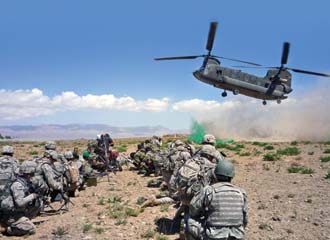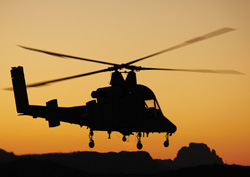Robocopters Reduce Resupply Risk
 |
The CH-47 Chinook helicopter, which has been used for decades to transport troops and supplies across the battlefield, potentially could fly without a crew if the Autonomous Aerial Cargo Utility Sensor System (AACUS) is installed. |
When U.S. Marines of the future come under enemy fire, they may be able to use a tablet or smartphone to call for ammunition, other supplies, or for air casualty evacuation by an autonomous helicopter smart enough to avoid hostile forces and safely land itself. The system under development is designed to save lives by reducing the need for manned flights or convoys that are used for resupply.
The Autonomous Aerial Cargo Utility System (AACUS) is a package of sensors and control technology, not a robotic helicopter platform. It will fit any vertical take-off and landing (VTOL) aircraft in the military fleet, making even decades-old aircraft such as the CH-47 Chinook or CH-53 Sea Stallion autonomous. “It’s fully platform-agnostic. It should be able to be mounted across VTOL platforms,” explains Mary Cummings, AACUS program manager with the U.S. Office of Naval Research (ONR). “And we’re hoping the system will be portable, meaning you could take it off one aircraft with little or no fanfare and attach it to another aircraft.” One advantage of portability, she points out, is that if one aircraft is inoperable because of mechanical or other issues, AACUS can be installed on another helicopter without affecting the mission.
According to ONR officials, Marines need an alternative means of providing time-sensitive logistics support to greatly dispersed locations. Unmanned cargo aircraft can be used to move tailored ammunition, supplies, fuel, water or weapons in adverse weather from the sea or ashore over harsh terrain. VTOL systems offer advantages over other logistics options, such as ground convoys, which often are threatened by improvised explosive devices. But manned helicopters have their own limits, such as weather, hostile conditions and crewing restraints.
A bloody history of resupply and casualty evacuation missions has highlighted the need for a smart, unmanned rotorcraft to do the job, Cummings contends. “AACUS is necessary because there is a need to get soldiers off the convoy route that makes resupply dangerous,” she says. “If we didn’t have problems with convoy resupply and casualty evacuation operations in hostile terrain, perhaps the need would not be so high. These are lessons learned in almost every conflict we’ve engaged in, but they are of course more acute because we are in Iraq and Afghanistan. It has only been with recent developments in technology that we can start to achieve these goals.”
Cummings adds that the resupply mission is the short-term goal for AACUS. Casualty evacuations are more long-term.
The ONR started the five-year, $98 million AACUS program at the beginning of the 2012 fiscal year and expects to hold its first field demonstration early in the 2014 fiscal year. The program schedule includes annual demonstrations after that, each one building on the previous one. The Navy held an industry workshop in November and released a broad agency announcement about the program in December. Proposals were due at the end of February.
The U.S. military has made recent strides in cargo delivery with unmanned aircraft. Namely, a detachment from Marine Unmanned Aerial Vehicle Squadron 1 in Afghanistan used an unmanned variant of the K-MAX helicopter to sling load three pallets—about 3,500 pounds—of food and supplies to troops at Combat Outpost Payne. The mid-December flight was the first unmanned aerial system cargo delivery in a combat zone. The unmanned K-MAX system is in Afghanistan for a six-month assessment to demonstrate its capabilities. After the six months, the Marine Corps will have the option to fully implement the system.
Even with recent accomplishments, AACUS will be a leap-ahead capability, ONR officials say. K-MAX, for example, requires someone with flight experience to control it. AACUS will not. “The goal is to get support from field personnel who have no aviation background. That person gives a call, and the aircraft responds. It then tries to get as close as it can to that customer on the ground,” Cummings says.
To do that, AACUS will need to be smarter than current unmanned rotorcraft. Cummings compares installing the system to giving the chopper a new frontal lobe. “It has to pick out its own landing site and ensure that it is safe to land, which could include static obstacles like boulders, but it could also include dynamic obstacles like cattle running across the field, or hostile fire,” Cummings says.
Despite those recent advances, technological challenges remain. For example, some systems now are capable of hovering over a potential landing site while the sensor technology maps the ground underneath. “There has been some success in that area, but it is essential for AACUS to move beyond that because in the world of Marine Corps operations, you simply are not going to have the time, nor is it safe, to hover over an intended landing site for a long period of time,” Cummings asserts. “Determining ground composition is some of the longer-term technology issues we’re looking at. One of the things we’re going to be working on is developing technology such that the helicopter can determine whether the selected landing site is hard packed or sand, or rocky terrain or a swamp.”
 |
The AACUS program works closely with the team developing the unmanned version of the K-MAX helicopter, which has been delivered to Afghanistan for evaluation. |
The ONR is working closely with the Marine Corps’ K-MAX development crew so that lessons learned on one program can be applied to the other. “One of the big items we’re tracking right now is that K-MAX has issues—as do most helicopters, manned or unmanned—flying in gusty wind conditions. Knowing they have to cancel K-MAX flights in theater because of gusty winds, I’ll be looking at how to potentially get around that with AACUS,” Cummings says.
The unmanned K-MAX system, which is being developed by Lockheed Martin and Kaman Aerospace, can transport up to 6,000 pounds of cargo and return to home base within one flight. The system includes mission management and flight control computers connected via datalinks to a ground controller. The controller uses a ruggedized laptop with command and control software to develop and upload a mission flight plan to the aircraft’s onboard computer. The controller can upload new mission plans at any time during flight.
ONR officials envision possible spin-offs of AACUS technologies. For example, AACUS potentially could be applied to aircraft used for civilian first-response or commercial ambulance flights. “We feel there is a good commercial transition possibility because there is a significantly high accident rate for air ambulance and commercial rotorcraft flights, particularly in first-response situations,” Cummings says.
Applications for fixed-wing aircraft also are within the realm of possibility. In addition, the system potentially could be employed on weaponized helicopters. It also could be used to deliver supplies via sling load or airdrop, but none of that currently is part of the program plan. The AACUS focus is on internal load carrying.
Cummings says she hopes to see some AACUS technologies become available relatively soon. “The program is scheduled to end in 2017, but that doesn’t mean we couldn’t have some derivative technologies spin off earlier that could start working their way toward fielded systems. Particularly, we’re looking at some of the landing obstacle detection technology and hoping it can be transitioned to manned helicopters in the next two to three years,” Cummings reports.
She concedes that the five-year schedule is aggressive, but she expresses confidence that the ONR will rise to the challenge. “While it’s going to require some focus, it’s certainly achievable in the time frame that we’ve set up,” she says.
WEB RESOURCES
AACUS Fact Sheet:
www.onr.navy.mil/Media-Center/Fact-Sheets/Autonomous-Aerial-Cargo-Utility-Systems.aspx
K-MAX: www.dvidshub.net/news/81698/unmanned-helicopter-makes-first-delivery-marines-afghanistan




Comments